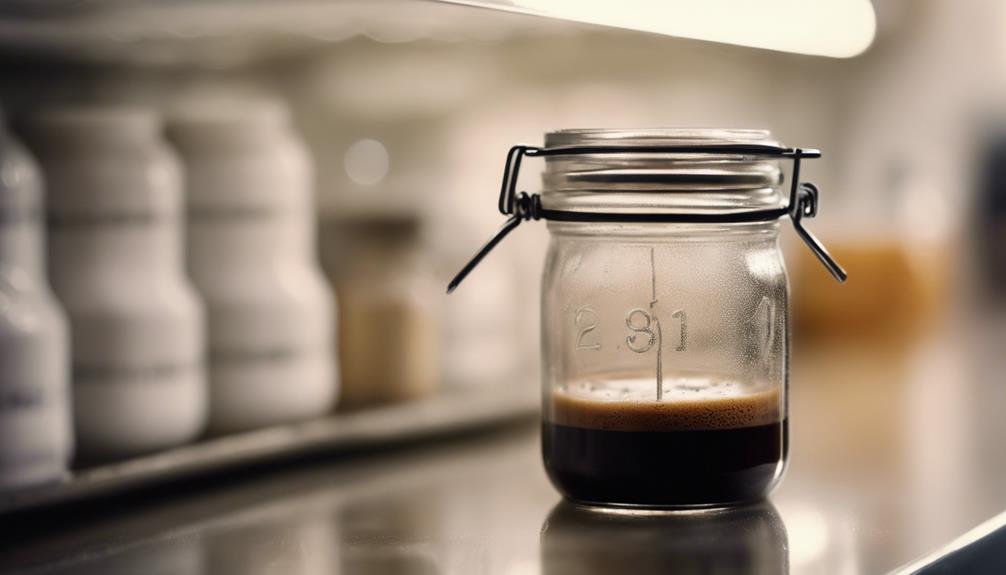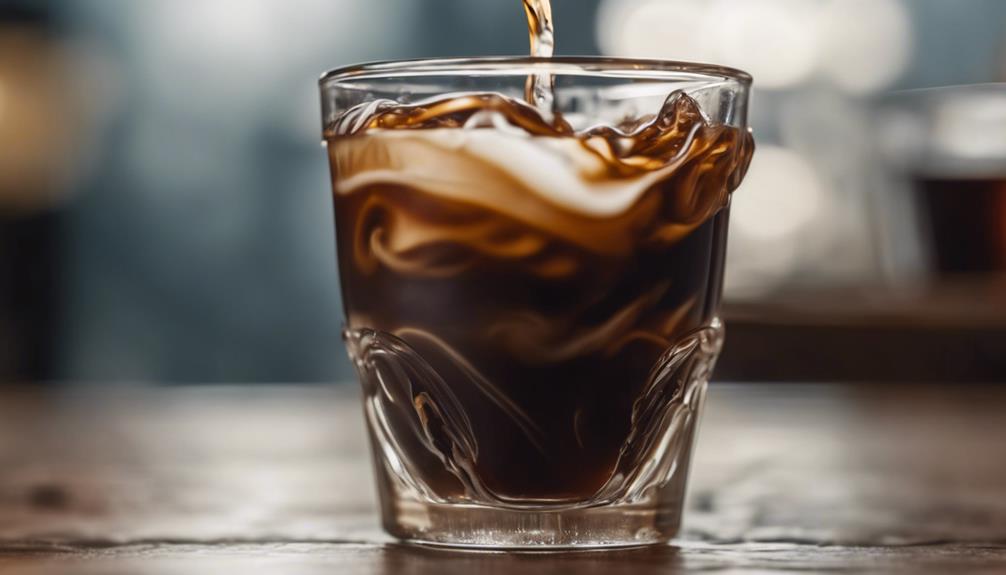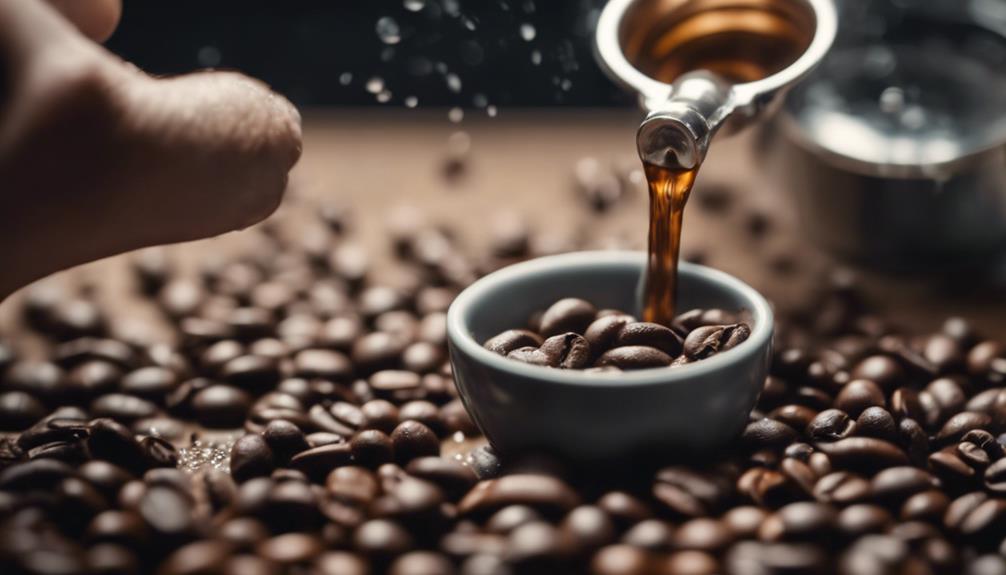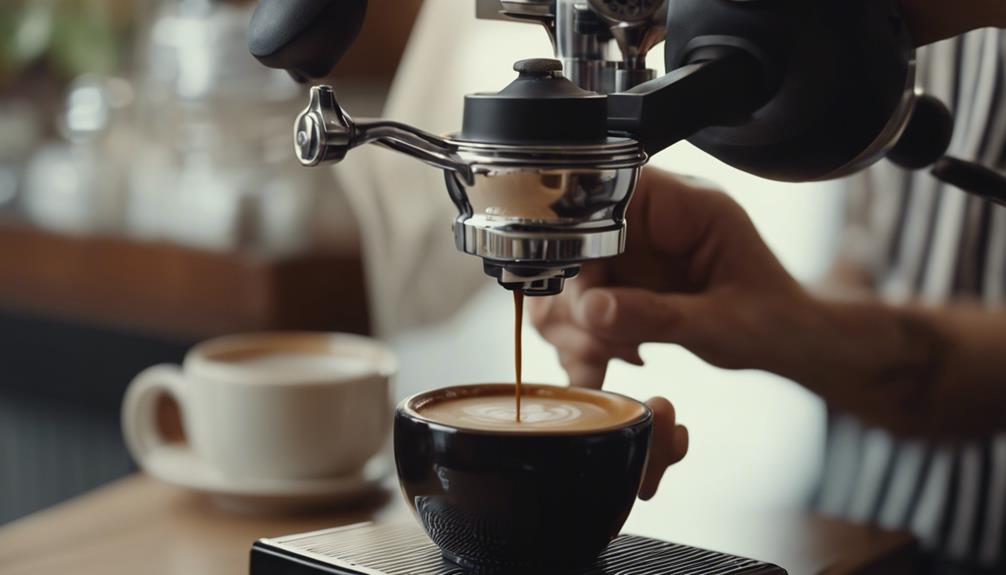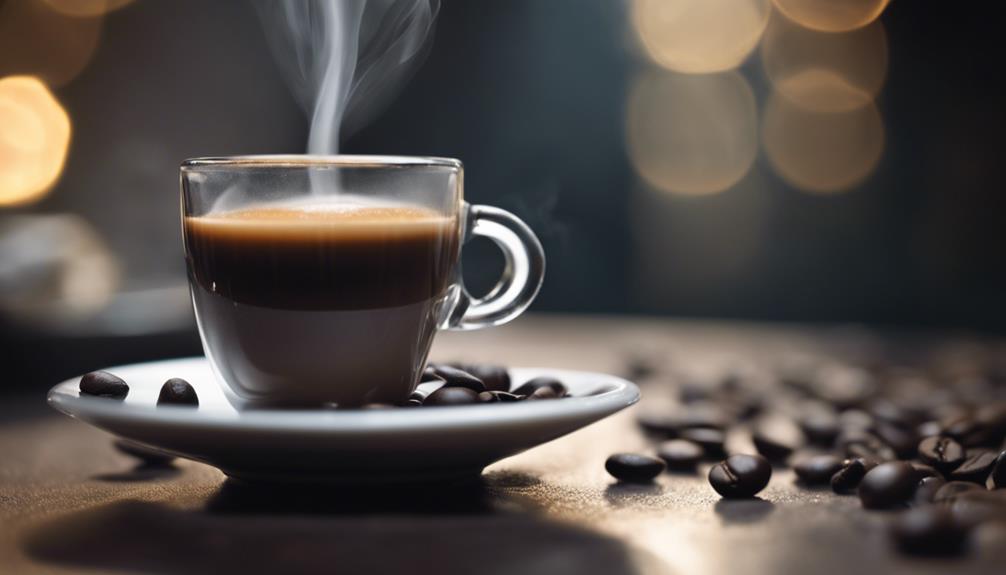When you store espresso properly in the refrigerator, it can stay fresh for 4 to 7 days. Factors such as additives, type of container used, and storage conditions all play a role in maintaining freshness. Espresso that contains dairy may spoil quicker, while adding sugar can help prolong its lifespan. To keep espresso fresh, store it in an airtight glass container in the coldest part of the fridge. Be sure to avoid temperature changes and keep it separate from any milk-based ingredients. Watch out for signs of spoilage like changes in flavor and crema. To extend the freshness even further, you can freeze espresso in ice cube trays. If the espresso goes stale, try reviving it with hot water instead of reheating it in the microwave. Remember, proper storage is crucial for maintaining the quality of your espresso.
Key Takeaways
- Store espresso in airtight glass containers in the coldest fridge section.
- Properly stored espresso can last 4-7 days in the fridge.
- Avoid adding milk or sweeteners to extend espresso shelf life.
- Check for flavor changes like bitterness or sourness to monitor freshness.
- Revive stale espresso with hot water or use it in coffee recipes.
Factors Affecting Espresso Shelf Life
Several factors greatly influence the shelf life of espresso stored in the fridge. When you keep espresso shots in the fridge, the type of drink and any additives, like milk or sweeteners, play an important role in how long the espresso will last.
For instance, dairy-based espresso drinks should be consumed within a few days to guarantee freshness. Additionally, the container in which you store your espresso matters. An open-lid container may lead to quicker oxidation, affecting the taste and quality of the espresso.
Furthermore, the addition of sugar can help extend the shelf life of espresso, but be cautious with honey or syrups as they can promote bacterial growth. To maintain the freshness of your espresso in the fridge, it's recommended to store it in an airtight glass container in the coldest part of the fridge and consume it within a reasonable timeframe.
Best Storage Practices for Espresso

To guarantee your espresso stays fresh and flavorful for the longest time possible, use an airtight container for storage in the fridge. By sealing your espresso shots in an airtight container, you prevent oxidation and preserve the rich taste. It's important to refrain from adding milk or sweeteners to your espresso if you aim to extend its shelf life. Store your espresso in the coldest section of the fridge to maintain its original flavor profile. Remember, espresso without any additives tends to last longer in the fridge compared to mixed drinks.
Utilizing an airtight container for your espresso shots is a simple yet effective way to ensure they remain at their best. This practice helps maintain the quality of your espresso by keeping it away from external elements that could compromise its taste.
When storing your espresso in the fridge, prioritize using an airtight container to lock in freshness and savor every sip of your favorite beverage.
Optimal Fridge Temperature for Espresso
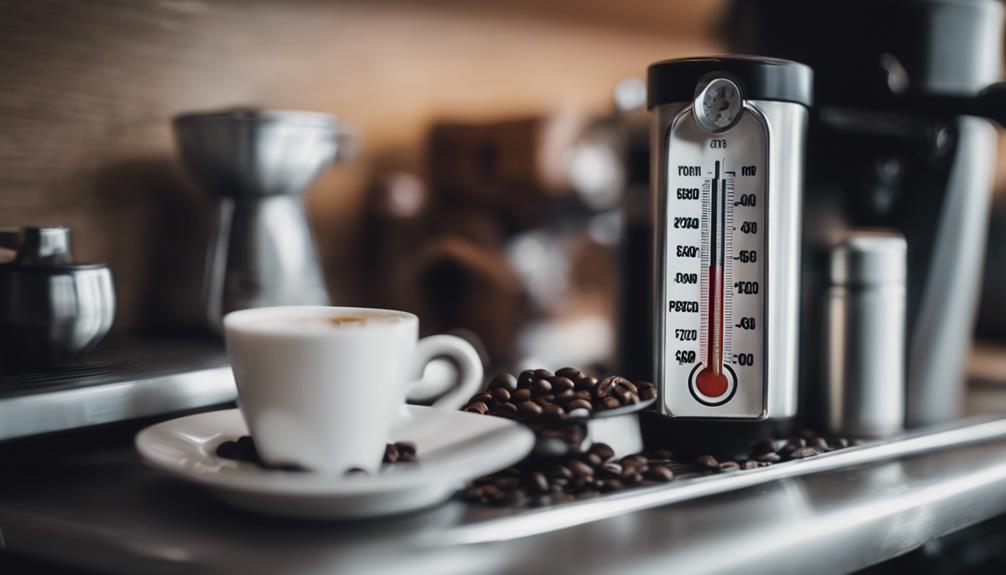
For ideal storage of espresso in the fridge, maintain a temperature range between 35-40°F to preserve its freshness and flavor.
Here are some tips to help you store your espresso properly:
- Maintain the Right Temperature: Keep your fridge set between 35-40°F to slow down oxidation and uphold the quality of your espresso.
- Avoid Temperature Fluctuations: Store your espresso away from the fridge door where temperatures can fluctuate, impacting the consistency of your stored espresso.
- Seal Tightly: Guarantee your espresso is tightly sealed in an airtight container to prevent it from absorbing any unwanted odors from other items in the fridge.
- Duration: Properly stored espresso can last 4-7 days in the fridge without significant loss of quality, allowing you to enjoy fresh-tasting espresso for several days after brewing.
Impact of Milk on Espresso Lifespan
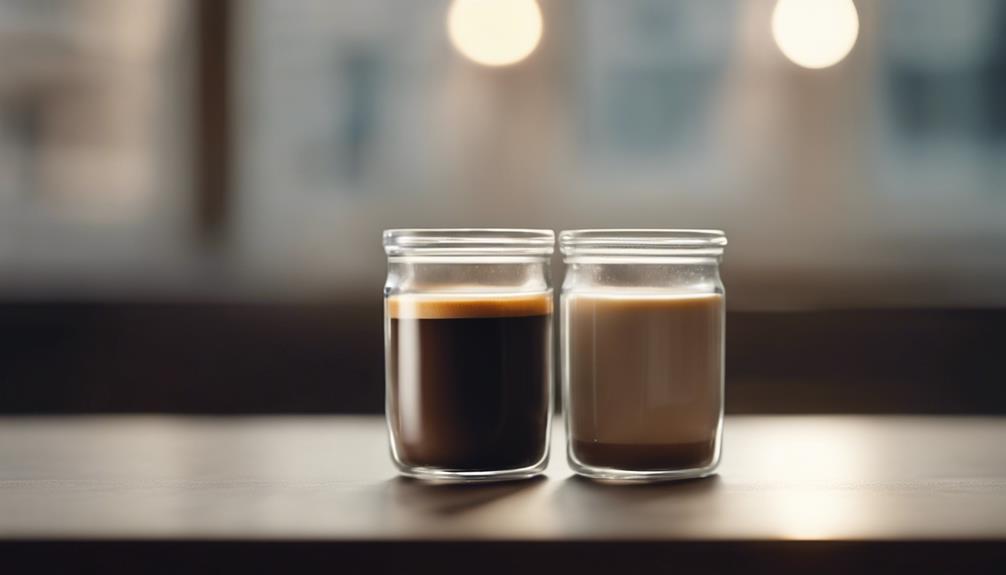
Adding milk to espresso in the fridge can greatly reduce its shelf life and impact its overall freshness. Milk, when combined with espresso, creates a breeding ground for bacteria, leading to quicker spoilage. This can result in an unpleasant taste and texture in your coffee. To help you understand better, here is a breakdown of how milk affects the lifespan of espresso in the fridge:
| Impact on Espresso Lifespan | |
|---|---|
| 1 | Reduces shelf life |
| 2 | Increases risk of bacterial growth |
| 3 | Affects taste and freshness |
To maintain the quality of your stored espresso, it is advisable to store it separately from any milk-based additives. By doing so, you can guarantee that your espresso lasts longer and tastes better when you finally enjoy it. Remember, freshness is key when it comes to a good cup of espresso, so take care when storing your coffee with milk in the fridge.
Espresso With Sweeteners – Shelf Life
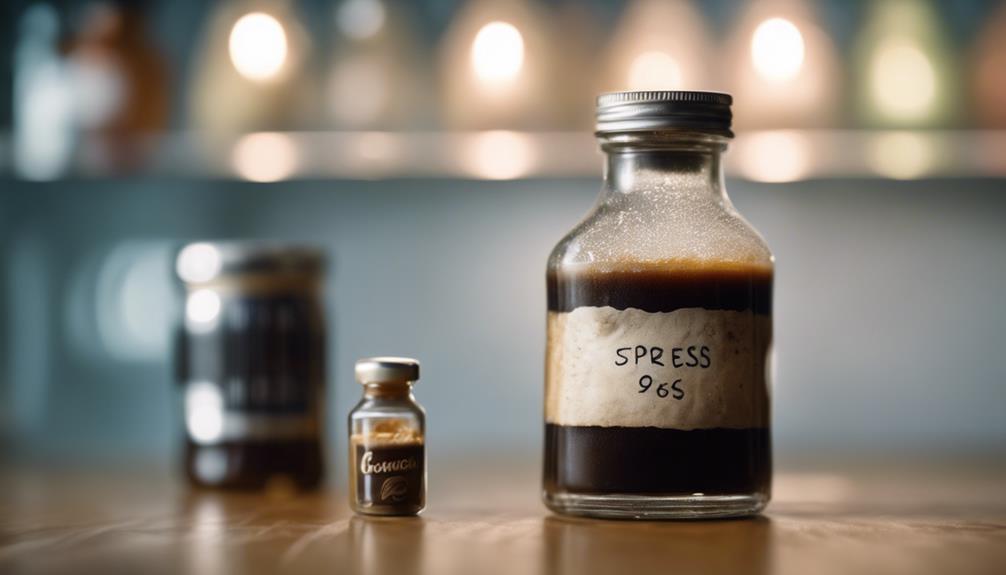
Sweetened espresso, such as those with added sugar, can prolong its shelf life in the fridge due to sugar's preserving properties.
However, be cautious with honey or syrups as they may lead to quicker bacterial growth, shortening the espresso's lifespan.
To maintain freshness and flavor, consume sweetened espresso within 4-5 days when stored properly in the refrigerator.
Sweetened Espresso Storage
To maximize the shelf life of sweetened espresso in the fridge, make sure it's stored in an airtight container. Here are some tips for storing your sweetened espresso:
- Use Airtight Containers: Seal your sweetened espresso in airtight containers to maintain its freshness and prevent it from absorbing odors from the fridge.
- Avoid Bacterial Growth: Sweeteners like honey or syrups can promote bacterial growth, so it's important to consume sweetened espresso within 3-4 days to avoid any health risks.
- Prevent Flavor Degradation: Leaving sweetened espresso in the fridge for too long can lead to a decline in its taste quality. Enjoy it at its best by consuming it within the recommended timeframe.
- Regularly Check for Spoilage: Keep an eye out for any signs of spoilage like off smells, unusual textures, or mold growth. When in doubt, it's best to discard the sweetened espresso to avoid any health issues.
Impact of Sugar
Sugar plays a crucial role in extending the shelf life of espresso drinks by acting as a natural preservative. When you add sugar to your espresso, you're not just sweetening your drink; you're also helping to prevent bacterial growth and spoilage.
The presence of sugar creates an environment that makes it harder for bacteria to thrive, keeping your espresso fresh for a longer period. However, it's important to note that using honey or syrups as sweeteners in your espresso may have the opposite effect. These sweeteners can actually promote the growth of bacteria, shortening the shelf life of your drink.
Proper Refrigeration Techniques
For peak freshness and longevity of your sweetened espresso, employ proper refrigeration techniques. Here are four essential tips to guarantee your espresso with sweeteners stays fresh in the fridge:
- Store in the Coldest Part: Keep your sweetened espresso in the coldest section of the fridge to maintain its flavor and quality for as long as possible.
- Use an Airtight Container: Seal your sweetened espresso in an airtight container to prevent odors from the fridge affecting its taste and to avoid any spills or leaks.
- Avoid Honey or Syrups: While sugar can extend the shelf life of espresso, honey or syrups may lead to bacterial growth, shortening the overall shelf life of your sweetened espresso.
- Check Expiry Dates: Regularly check the expiration dates of your sweeteners to make sure they're still safe to consume and won't affect the quality of your espresso.
Signs of Espresso Deterioration

When espresso deteriorates, you may notice a loss of its rich aroma and changes in flavor.
The once vibrant and intense taste can become dull and flat.
These alterations are key indicators that your espresso may have passed its prime.
Aroma Loss
Stale espresso is easily identifiable by the loss of its aromatic notes and the development of a flat, dull smell. This aroma loss is one of the primary signs of espresso deterioration, often caused by improper storage. Here are some key points to ponder regarding the aroma loss in espresso:
- Quick Dissipation: Aromas can dissipate rapidly in the fridge, leading to a diminished flavor experience when you finally enjoy your espresso.
- Common Indicator: Loss of aroma serves as a common indicator of espresso deterioration and reduced freshness.
- Preservation: Proper storage in an airtight container can help safeguard the aromatic qualities of espresso, maintaining its full-bodied flavor profile.
- Smell Test: Before consuming espresso, take a moment to smell it. The aroma can provide valuable insights into whether the espresso has maintained its desired scent and flavor.
Understanding the importance of aroma preservation can enhance your espresso experience and ensure you relish a flavorful cup every time.
Flavor Changes
Loss of crema and flavor in your espresso can be telltale signs of deterioration, with bitter, sour, and acidic tastes indicating the espresso may have degraded in the fridge.
When you notice a change in the crema on top – that beautiful golden layer of foam that characterizes a fresh espresso – or if the flavors seem off, it's likely that your espresso has started to go stale.
As time passes, the bitterness and acidity in your cold espresso can intensify, leading to a less-than-ideal taste experience.
To prevent these flavor changes, it's vital to store your espresso properly in the fridge. By ensuring airtight containers and shielding your espresso from light and temperature fluctuations, you can help maintain its freshness and flavor profile for a longer period.
Freezing Espresso for Extended Storage

Curious about how to prolong the freshness of your espresso for an extended period? Freezing espresso is a great way to guarantee your favorite brew stays flavorful for longer.
Here are some tips to make the most out of freezing espresso:
- Use Ice Cube Trays: Pour leftover espresso into ice cube trays to freeze into convenient portions.
- Store Coffee Beans: Grind fresh coffee beans just before brewing a shot of espresso for the best flavor.
- Freeze in a Plastic Bag: After freezing the espresso in ice cube trays, transfer the cubes into a plastic bag for easy storage and to prevent freezer burn.
- Preserve Flavor Indefinitely: Properly stored frozen espresso can maintain its flavor almost indefinitely, allowing you to enjoy your favorite shot of espresso whenever you crave it.
Reviving Stale Espresso
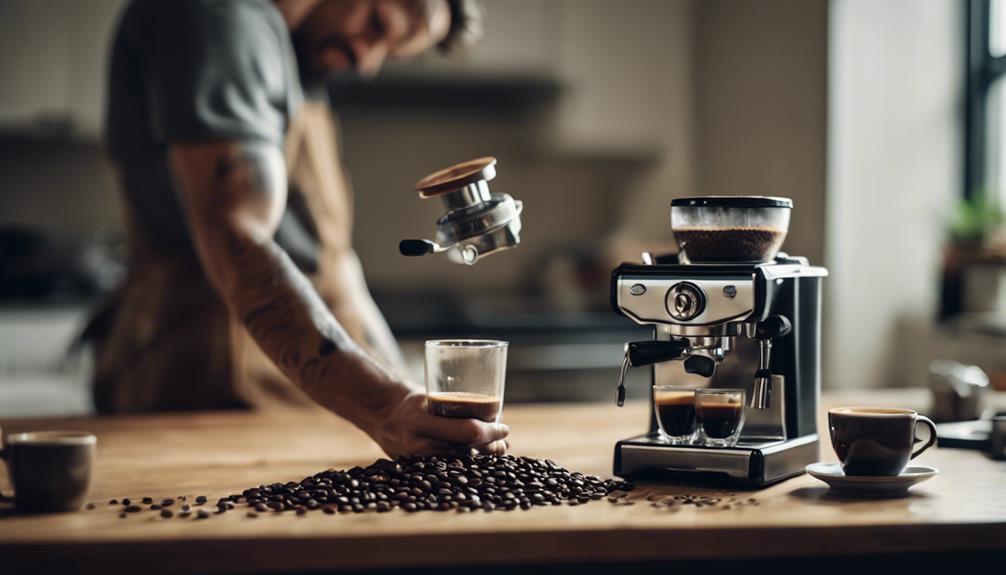
To bring back the flavor of your espresso that has lost its freshness, consider reviving it with a simple technique. When your espresso starts to taste stale, you can make it more enjoyable to drink by adding a small amount of hot water and stirring well. This method helps to bring out some of the lost flavors and revive the drink to a certain extent.
However, avoid the temptation to reheat stale espresso in the microwave, as this can actually make the flavor worse. Another trick to improve the taste of stale espresso is to add a shot of freshly brewed espresso to it. This can help enhance the overall flavor profile and make the drink more palatable.
If you prefer a creamier option, try diluting the stale espresso with a splash of milk or cream to mask some of the off flavors. Additionally, you can repurpose stale espresso in recipes that call for coffee, such as tiramisu or other coffee-flavored desserts. These techniques can help make your stale espresso last a bit longer and more enjoyable to consume.
Maximizing Espresso Freshness
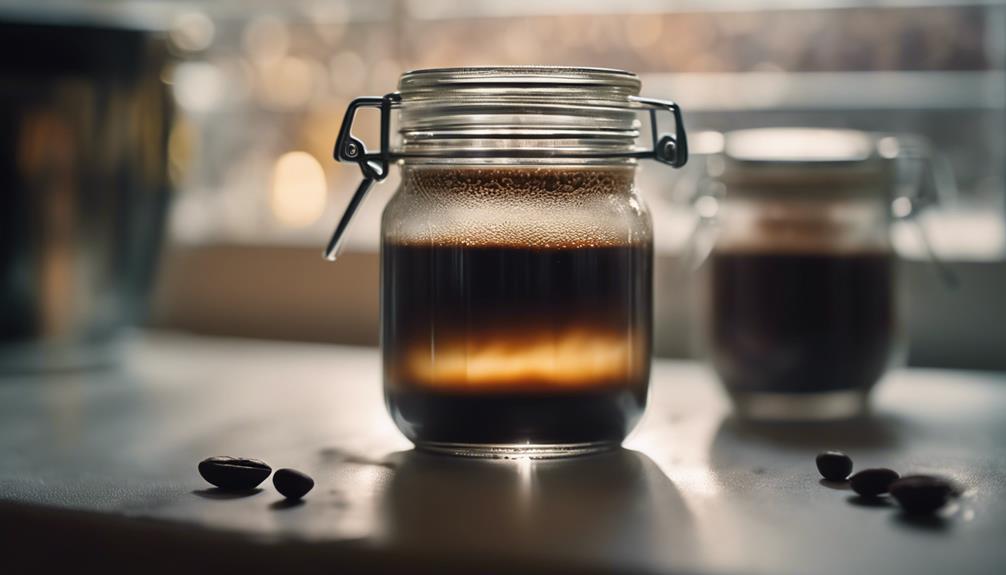
For peak freshness of your espresso, be sure to store it in an airtight container in the coldest part of your fridge.
To maximize the shelf life and quality of your espresso, follow these simple tips:
- Use an Airtight Container: Storing your espresso in an airtight container helps prevent exposure to outside odors and moisture, preserving its rich flavor for a longer period.
- Avoid Adding Milk or Sweeteners: To extend the freshness of your espresso in the fridge, refrain from adding milk or sweeteners until you're ready to enjoy it. This helps prevent the beverage from spoiling quickly.
- Keep it in the Coldest Part of the Fridge: Placing your espresso in the coldest part of the fridge, typically the back of the lower shelves, helps maintain a consistent temperature, ensuring the espresso stays fresh for a longer duration.
- Monitor Flavor Degradation: While espresso can last for 4-7 days in the fridge, keep an eye on any gradual flavor degradation over time to make sure you enjoy it at its best.
Frequently Asked Questions
Can You Pre Make Espresso and Refrigerate It?
Yes, you can pre-make espresso and refrigerate it. It's advised to consume refrigerated espresso within a few days for the best flavor.
Adding milk or sweeteners can reduce its shelf life. Storing espresso in an airtight glass container in the coldest part of the fridge helps maintain freshness.
While flavors may degrade over time, proper storage can help preserve the quality of pre-made espresso shots.
What Is the Shelf Life of an Espresso Shot?
Espresso shots, when stored properly, can maintain their quality for about 4-7 days in the fridge. However, be cautious when adding milk or sweeteners as they can reduce the shelf life.
For best freshness, store your espresso in an airtight container. Shots without additives tend to last longer.
Can You Drink Day Old Espresso?
You can drink day-old espresso, but its flavor and aroma may have deteriorated, becoming bitter, sour, or flat. The crema might've dissipated, affecting the overall quality.
Storing espresso in the fridge can lead to a loss of freshness and complexity. While it might still be safe, consuming day-old espresso may not offer the best coffee experience you'd get from a freshly brewed shot.
How Long Can I Keep Brewed Coffee in the Fridge?
You can keep brewed coffee in the fridge for about 1-2 weeks, but its flavor deteriorates over time. To maintain freshness, store it in an airtight container.
After 24 hours, the taste may become bitter or sour. Avoid adding milk or sweeteners for extended storage.
For the best flavor, aim to consume your brewed coffee within the first few days. Remember, fresher coffee equals better taste.
What is the Shelf Life of Espresso in the Fridge?
When it comes to espresso storage tips, it’s important to keep in mind that the shelf life of espresso in the fridge is about 7-10 days. To maintain its freshness, store it in an airtight container and avoid exposure to light, air, and moisture. Keep your espresso beans or grounds in the original packaging or a sealed container to preserve their flavor.
Conclusion
To sum up, espresso can last up to 2 weeks in the fridge when stored properly.
For example, a study conducted by a coffee connoisseur showed that using an airtight container and keeping the fridge at a consistent temperature of 34°F extended the shelf life of their espresso.
By following best storage practices and monitoring signs of deterioration, you can maximize the freshness of your espresso and enjoy a delicious cup every time.
